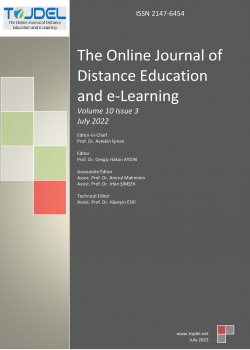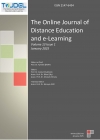TOJDEL - Volume 10 - Issue 3 - July 2022
 A 3- YEAR COHORT STUDY OF INTERNET USE AND PARENT-CHILD RELATIONSHIP AMONG SENIOR SECONDARY SCHOOL STUDENTS
A 3- YEAR COHORT STUDY OF INTERNET USE AND PARENT-CHILD RELATIONSHIP AMONG SENIOR SECONDARY SCHOOL STUDENTS Raj Sharan Shahi, Vivek Nath Tripathi, Adbhut Pratap Singh
Abstract:
The advent and expansion of the internet have revolutionized education systems, aided in universal access to education, and transformed traditional teaching. However, disparities in internet use persist based on a variety of factors, including gender. Also, the internet is used by the students for different purposes classified as curricular educational, extra-curricular educational, social, and recreational use in this study. Moreover, little is understood about the impacts of intensified internet use on the parent-child relationship which consists of different attributes viz. affection, intimacy, companionship, guidance, enhancement of the worth, guidance, and satisfaction. The data was collected using a cohort study survey design from students in senior secondary school who were recruited using a stratified sampling technique and a self-constructed questionnaire in two stages (2018 and 2021; N1 = 394, N2 = 376). The findings reveal a disparity in pattern and intensity of internet use among males and females and across phases. Furthermore, the parent-child connection differed significantly by gender and phase. Female students were found to have better parent-child relations than male pupils. Also, the parent-child relationship is degraded over time. Moreover, the intensity of internet use was negatively correlated with the parent-child relationship.
 ATTITUDE OF HIGHER SECONDARY SCHOOL STUDENTS TOWARDS ONLINE EDUCATION IN THE DISTRICT OF DAKSHIN DINAJPUR, WEST BENGAL
ATTITUDE OF HIGHER SECONDARY SCHOOL STUDENTS TOWARDS ONLINE EDUCATION IN THE DISTRICT OF DAKSHIN DINAJPUR, WEST BENGAL Sujan Sarkar, Pranab Barman
Abstract:
In the present study an attempt has been composed by the investigators to investigate the attitude level of higher secondary level school students towards online education in Dakshin Dinajpur district, West Bengal. To fulfil this study the researcher adopted descriptive survey research method. The researcher collected the data from 250 samples selected through simple random sampling based on the self-made five-point Likert scale. Mean, SD and t-test have used for data analysis with the help of SPSS 2.0. Finally, the results have been seen that, the overall attitude level of higher secondary level students in Dakshin Dinajpur district towards online education is moderate. Male-female, rural-urban and arts-science students have shown their same level attitude towards online education, they did not significantly different from each other. But obtained by the mean scores of students it has found that, female students have comparatively more favourable attitude towards online education than the male students, urban students have comparatively more favourable attitude towards online education than the rural students and arts students have comparatively more favourable attitude towards online education than the science students.
 ATTITUDES AND EXPERIENCES OF UNDERGRADUATE COLLEGE STUDENTS IN INDIA REGARDING ONLINE LEARNING- A CROSS- SECTIONAL STUDY
ATTITUDES AND EXPERIENCES OF UNDERGRADUATE COLLEGE STUDENTS IN INDIA REGARDING ONLINE LEARNING- A CROSS- SECTIONAL STUDY CT Sudhir Kumar, Anish KR, Mathew Kanamala
Abstract:
Educational sector has suffered massive setbacks following the onset of Covid-19 pandemic. Educational institutions have been closed for varying periods of time and switched to online mode of learning. This study aimed at exploring the current practices, experiences, attitudes and perceptions of online learning and teaching among college students using a comprehensive online survey.
Of the 617 students who participated in the survey 84% were females. Most (69.7%) of them belonged to the age category 20 to 30. 69.7% were from a rural background. 65.8% were aware of online teaching methods before the pandemic but only 30.8% had used it before. 62.7% had experience of using smartphones for a period of 1 to 5 years. The online platform used by around half the participants was Google meet. 561 (90.9%) used smartphones to attend classes. Majority (259, 42%) of participants are able to concentrate only for about 30 minutes at a stretch while attending online classes. 57.3% students reported online learning methods easy or very easy to use and 97.4% students found the sessions useful in general. Majority of the participants (450, 73%) are happy with the overall experience of online learning. Most of the students are in agreement that internet-based meetings are useful, easy to use and provide effective learning environment. Majority also reported that when compared to face-to-face meetings, online meetings are less effective and there is less interaction in online teaching. 129 (33.3%) are definite they would use internet based learning and related facilities regularly in the future.
To the best of our knowledge this is one of the first comprehensive studies which closely looked at the experience of college students in attending online classes. Having known the benefits of online learning, it is highly likely this approach continues to play a significant role in the future and a hybrid learning method may be the way forward. These findings assume great importance on the back of how prepared and ready are learners to accept this new form of education.
 DIDAKTIK FOR DISTANCE EDUCATION IN SECONDARY AND ADULT EDUCATION
DIDAKTIK FOR DISTANCE EDUCATION IN SECONDARY AND ADULT EDUCATION Charlotta Hilli, Anna Ă…kerfeldt
Abstract:
This article presents secondary and adult education teachers’ perceptions of their distance teaching practice in Sweden. The teachers participated in a professional development program from 2019–2022. A Didaktik theory was used to analyse factors for distance education on structural (e.g., content, intentions, methods, media, students, sociocultural contexts) and faculty (e.g., organisational, curriculum) levels. The primary empirical material is group interviews with distance teachers and coordinators during a Design-Based research process. The analysis suggests that the teacher groups developed professionally as distance teachers by reflecting on and testing different ways to communicate (synchronously, asynchronously) and teach online. The article suggests Didaktik principles to improve distance education at structural and faculty levels.
 EMBRACING DIGITAL TRANSFORMATION OF ACADEMIC LEARNING DURING AND POST COVID PANDEMIC ENVIRONMENT
EMBRACING DIGITAL TRANSFORMATION OF ACADEMIC LEARNING DURING AND POST COVID PANDEMIC ENVIRONMENT BilquisFerdousi, Jamal Bari
Abstract:
This study examines the major challenges in digital transformation of learning content and how to overcome those
obstacles for smooth delivery of classes in fully online mode in the post COVID pandemic environment. It has
been found that among other factors the logistic supports such as availability of learning tools, equipment, and
software, etc., which is crucial for successful online learning delivery, plays an important role in effective digital
transformation of learning content. Especially the digital divide among the student population is a major challenge
as it hinders the availability of learning tools, equipment, and software for students. Instructors’ extra work load
can also be a significant issue. Another important factor to ensure effective online learning is its quality. The design
and development of improved online courses must be based on the criteria of online learning quality standards.
Also, the active communication and interaction between instructors and students in class is an important factor.
Finally, the collaboration among faculty members, administrators, and e-learning technologists play vital role in
the success of the digital transformation of academic learning process.
 GENDER DIGITAL DIVIDE IN KERALA, INDIA- AN EXPLORATORY ANALYSIS AT MICRO-LEVEL
GENDER DIGITAL DIVIDE IN KERALA, INDIA- AN EXPLORATORY ANALYSIS AT MICRO-LEVEL Golda Godly, Baiju K.C.
Abstract:
The recent National Family, Household Survey-5 of India, reveals a stark discrepancy between men and women
who use the Internet in 22 states and Union territories. The present study examines the existence and extent of the
gender digital divide in Kerala, a region in India acclaimed for a unique model of social and economic
development. A micro-level exploratory analysis using data collected from a sample of 200 households randomly
selected from two strata viz: *Kudumbasree (n1=100) and non-kudumbasree (n2=100) members from a Panchayat
in the district of Ernakulam, Kerala, India. The data collected using a self-administered questionnaire were
analysed using SPSS software. Multiple Logistic Regression predicts internet usage based on the sociodemographic
profile. The study found that women who use the internet are more significant than men. Internet
penetration among the kudumbasree homemakers is more than the non-kudumbasree homemakers in the
panchayat. The micro-level findings that emerged from the study contradict the national and state-level patterns
regarding the gender digital divide. The study identified a significant association between socio-demographic
variables such as age, gender, education, family size, economic status and internet usage.
(*Neighbourhood Help Group comprise of women).
 INFLUENCE OF SOCIAL MEDIA ON SOCIAL RELATIONSHIPS AND ACADEMIC ACHIEVEMENTS
INFLUENCE OF SOCIAL MEDIA ON SOCIAL RELATIONSHIPS AND ACADEMIC ACHIEVEMENTS Momin Sumaiya, Siddiqui Mohd. Mahmood
Abstract:
India is an active user county in the world in terms of using social media. We live in a socially networked period, where everyone is connected through a network of social media, and that too at a very low cost. Technology has evaporated the limits of social connections among friends and family staying far and even with strangers. The utilization of social media sites among young people has increased drastically and impacted their daily life. This paper aims to study the pattern of use of social media sites and their correlation with university students’ social relationships and academic achievements. Through random sampling 100 post-graduate students (50 boys and 50 girls) from MANUU (A Central University), Hyderabad (India) were selected. One standard tool named Social Relationship Scale (SRS-KPFNNT) and one self-developed tool named Social Media Usage Scale were used for data collection.
The researchers found that YouTube, followed by WhatsApp are the most liked social media site among the sample students. Students are having at least 2 social media site accounts. They found significant differences in usage of social media sites among students in relation to their type of families) and social relationships (among students in relation to their gender). Further, they found a remarkable correlation between usage of social media sites and social relationships.
 ONLINE LEARNING AMONG THE STUDENTS OF FISHERMEN COMMUNITY DURING COVID 19
ONLINE LEARNING AMONG THE STUDENTS OF FISHERMEN COMMUNITY DURING COVID 19 Gopika J S, Rekha R V
Abstract:
COVID 19 outbreak has significantly and severely impacted the education system worldwide. As a means to cope with this unforeseen situation, all the academic activities were shifted to the online platform. However, simply converting offline content online is not enough to provide learners with a unified digital learning experience. Proper learning conditions are equally important as the content delivered. Therefore, in this study, we aimed to discover the acceptance of online learning among school students from the marginalised fishermen community in Kerala, India. The study's findings indicate that students lack interest in online learning. They are facing many problems that diminish the actual benefit of online learning. This study suggests that the government should take adequate measures to provide impartial delivery of education by enhancing students' online learning experience.
 REFLECTIONS OF UNIVERSITY STUDENTS TOWARDS ONLINE LEARNING: AN ANALYSIS
REFLECTIONS OF UNIVERSITY STUDENTS TOWARDS ONLINE LEARNING: AN ANALYSIS Dipak Bhattacharya, Sunandita Bhowmik, Sanjukta Sahoo, Biswajit Bhowmik
Abstract:
Online learning is a kind of internet-based distance learning. The word e-learning can be exchanged as online
learning. Online learning includes online classes, exams, game-based competitions, certification training etc.
University students can use online learning to engage in digital programming and learning process at any time
and they can easily connect to the web platform from home. The study examines the reflections of university
students towards online learning.The study also assesses the reflections of university students towards teachers’
skills and competencies. The present study follows descriptive survey research. This study is conducted in State
University, Central University and Deemed University of West Bengal. Researchers have taken 91 social
sciences students as sample of the study by using purposive sampling method. Online questionnaire is used in
order to collect information from university students for the study. The study found that female students have
better reflections towards online learning than male students. 56% of the university students have positive
reflections towards teachers’ skills and competencies regarding online classes. Only 44% university students
have positive reflections towards online learning assessment.
 STUDENTS’ ATTITUDE AND INTENTIONS TOWARDS ONLINE LEARNING IN HIGHER EDUCATION: EXAMINING THE ROLE OF INDIVIDUAL AND SYSTEM CHARACTERISTICS
STUDENTS’ ATTITUDE AND INTENTIONS TOWARDS ONLINE LEARNING IN HIGHER EDUCATION: EXAMINING THE ROLE OF INDIVIDUAL AND SYSTEM CHARACTERISTICS Krishna Murari, Sharya Rai
Abstract:
This study is aimed at examining the factors predicting the university students’ attitudes and intentions to use
online learning system with the intervention of individual and system-related characteristics as external factors.
We used 506 responses from undergraduate and post-graduate students enrolled in public and private universities
in the state of Sikkim (India). The study adopted the Technology Acceptance Model (TAM) as a theoretical
foundation, and we extended it with external individual and system-specific characteristics. We employed Partial
Least Square Structural Equation Modelling (PLS-SEM) to assess the relationship between the external exogenous
individual (computer self-efficacy, perceived enjoyment, and computer playfulness) and systems (content quality,
information quality, and system quality) characteristics with the endogenous constructs.
The theoretical model we propose effectively explains the behavioural intention (R2 = 0.623) of university students
using online learning systems. The results suggest that perceived enjoyment and system quality have a significant
impact on the perceived usefulness and perceived ease of use of online learning system. On the other hand,
computer self-efficacy, computer playfulness among individual characteristics; and content quality & information
quality characteristics of online learning system do not significantly affect the perceived use and perceived ease
of use of online learning system. Further, the content quality does not affect the attitude and intentions of using an
online learning system.
This study provides insightful information that will help universities and governments better prepare for the
adoption of online learning in the context of higher education in developing nations like India.
 THE MYSTERIOUS MANTLE OF TECHNOLOGY: ELABORATIVE ANALOGY AND DISTANCE EDUCATION
THE MYSTERIOUS MANTLE OF TECHNOLOGY: ELABORATIVE ANALOGY AND DISTANCE EDUCATION G. Mihalyi Szirony, Jason D. Kushner
Abstract:
With continuing expansion of online learning and an increase in the use of computer technology, the complexity of
technology can complicate the understanding of computer concepts. Elaborative analogy may help to enhance
understanding and speed the learning process. With the ever increasing growth of computer use and technology in
online education, the purpose of this study was to empirically evaluate a model of teaching and online learning
designed to help students better understanding of basics of technology. A model of elaborative analogy was
developed by the authors modeled after the Human Information Process (HIP) with the intention of enhancing the
understanding of ubiquitous computer technology used throughout online education. A cognitive map may be drawn
to assist students in the assimilation of new knowledge regarding basic computer understanding and function in
relation to the HIP. Perceptions and attitudes toward the efficacy of the model were examined in this study. Results
of a survey designed to measure student (n = 64) perceptions about an expanded Input-Process-Output (EIPO) model
of computer technology were found to be favorable overall and support the need for further research.
 UNDERGRADUATE STUDENTS’ ATTITUDE TOWARD E-LEARNING: GENDER AND STREAM OF EDUCATION PERSPECTIVES
UNDERGRADUATE STUDENTS’ ATTITUDE TOWARD E-LEARNING: GENDER AND STREAM OF EDUCATION PERSPECTIVES Namita Sahu, Venkateswar Meher, Sanjay Sahu, Neena Dash
Abstract:
The present study is designed to examine the attitude of undergraduate students towards e-learning in the COVID era. The objectives of this investigation were to examine undergraduate students’ attitudes toward e-learning in the COVID era and to compare undergraduate students’ attitudes towards e-learning in terms of gender and stream of education. A sample of 180 undergraduate boys and girls belonging to Arts, Science, and Commerce streams were selected from the population using a stratified random sampling technique. The findings of the study showed that about 46.67% of undergraduate students were having a neutral attitude toward e-learning in the COVID era. The finding also showed gender and stream of education as significant predictors of attitude towards e-learning. Undergraduate girls were having a more positive attitude toward e-learning as compared to boys. Undergraduate students belonging to Commerce stream were having a more positive attitude towards e-learning as compared to the students belonging to Ars and Science stream. There was no significant influence of the interaction between gender and stream of education on the attitude of undergraduate students towards e-learning in the COVID era. The results of the study were discussed and the implications were described.


